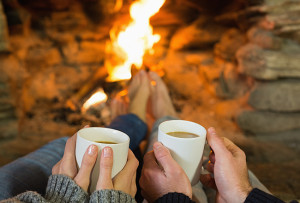
The days are getting shorter and cooler as we head into the winter months. If you're lucky enough to have a wood fireplace in your home, it's probably going to get some use soon. Not only are wood fireplaces beautiful, they're a great way to save on energy and utility bills. But before you spark up the fireplace for the first time, follow these five fireplace safety tips so everything is in working order.
1. Maintain your chimney
Did you know it's recommended that chimneys be swept at least once a year to remove soot and debris? If this isn't something you do on a yearly basis, start now. Besides sweeping your chimney, there are other tasks you should be performing yearly, including checking that the chimney cap is secure, so outside debris or animals can't get inside.
2. Stock your rack with seasoned hardwood
You should always choose seasoned, dense wood that has been dry for at least six months. This will keep the fire burning smoothly with less thick, dark smoke that causes build-up in your chimney. In addition, don't add too much wood to your fire. With smaller fires, you'll have less smoke and less heat. High temperatures can cause issues in chimneys like cracking, in addition to soot build-up.
3. Check the area surrounding your fireplace
One of the most important fireplace safety tips to follow is to check that your smoke alarm is in good working order, especially the one nearest the fireplace. In addition to updating the batteries every spring and fall, you should test the alarm periodically.
Remove all wall hangings or decorations that may be placed near the hearth. During warmer seasons, you may tend to decorate around your fireplace, but when it's being used, it should be clear of debris and decor.
4. Install a carbon monoxide alarm
Almost all homes have smoke detectors installed, but a great practice of fireplace safety involves carbon monoxide alarms as well. Slow burning fires can contribute to higher levels of carbon monoxide in your home, which means if you have a fireplace, you should definitely have one installed. An alarm that hooks into a monitoring service means your home's carbon monoxide levels are being monitored at all times — even when you're asleep or away from home.
While carbon monoxide alarms cost little and are easy to maintain, just like smoke alarms, the effects of having one can greatly affect your family's safety.
5. Remove ashes and debris after a fire
Last but not least, cleaning your hearth is an important aspect of fireplace safety. Remove all ashes and debris left behind. To safely dispose of ashes, they must be completely cooled. Douse them with water before disposal.
Having a fireplace in your home is a beautiful and great way to heat your home, but fireplace safety should always be a concern as you light the logs in the winter. By following these tips, you'll safely enjoy a warm and toasty winter with your family all season long.
Discuss your home safety options with a Vivint representative today.


